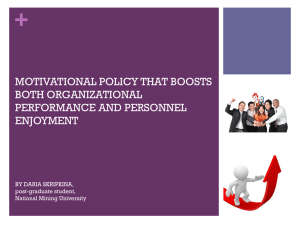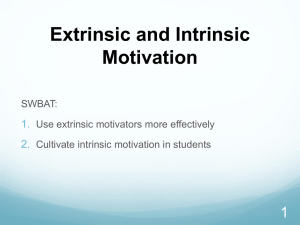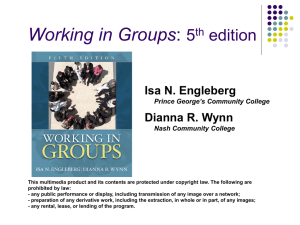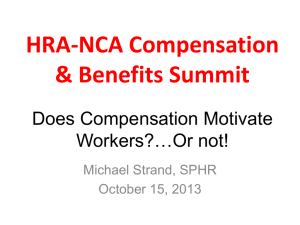Pink Notes - Drive - Haiku Learning : Login
advertisement
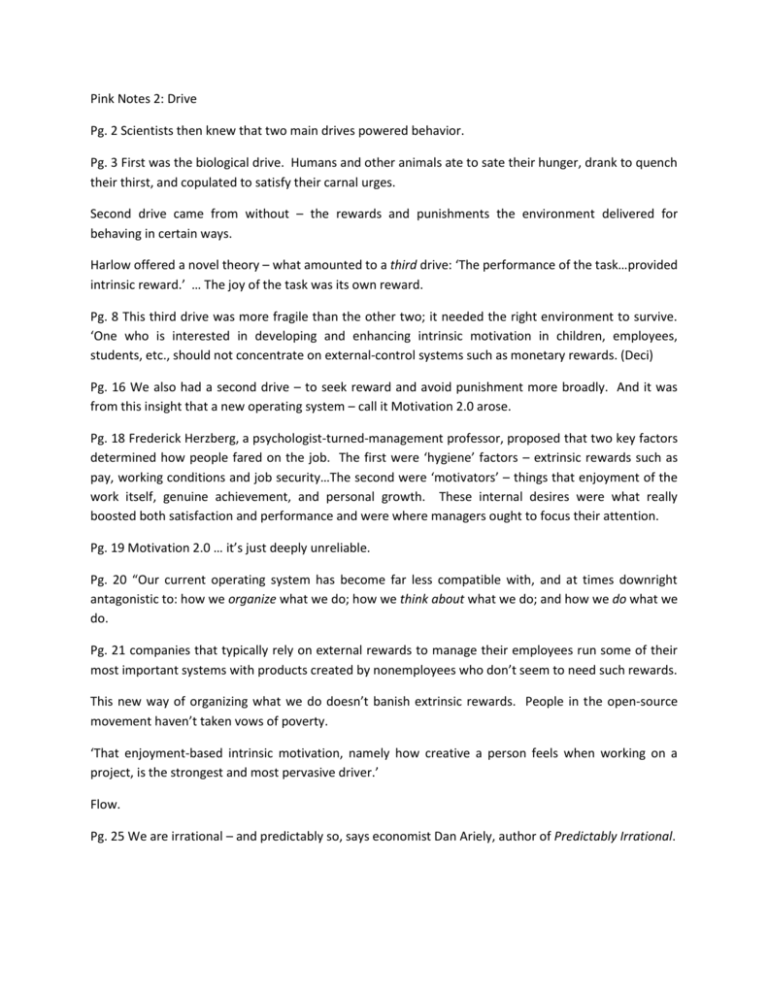
Pink Notes 2: Drive Pg. 2 Scientists then knew that two main drives powered behavior. Pg. 3 First was the biological drive. Humans and other animals ate to sate their hunger, drank to quench their thirst, and copulated to satisfy their carnal urges. Second drive came from without – the rewards and punishments the environment delivered for behaving in certain ways. Harlow offered a novel theory – what amounted to a third drive: ‘The performance of the task…provided intrinsic reward.’ … The joy of the task was its own reward. Pg. 8 This third drive was more fragile than the other two; it needed the right environment to survive. ‘One who is interested in developing and enhancing intrinsic motivation in children, employees, students, etc., should not concentrate on external-control systems such as monetary rewards. (Deci) Pg. 16 We also had a second drive – to seek reward and avoid punishment more broadly. And it was from this insight that a new operating system – call it Motivation 2.0 arose. Pg. 18 Frederick Herzberg, a psychologist-turned-management professor, proposed that two key factors determined how people fared on the job. The first were ‘hygiene’ factors – extrinsic rewards such as pay, working conditions and job security…The second were ‘motivators’ – things that enjoyment of the work itself, genuine achievement, and personal growth. These internal desires were what really boosted both satisfaction and performance and were where managers ought to focus their attention. Pg. 19 Motivation 2.0 … it’s just deeply unreliable. Pg. 20 “Our current operating system has become far less compatible with, and at times downright antagonistic to: how we organize what we do; how we think about what we do; and how we do what we do. Pg. 21 companies that typically rely on external rewards to manage their employees run some of their most important systems with products created by nonemployees who don’t seem to need such rewards. This new way of organizing what we do doesn’t banish extrinsic rewards. People in the open-source movement haven’t taken vows of poverty. ‘That enjoyment-based intrinsic motivation, namely how creative a person feels when working on a project, is the strongest and most pervasive driver.’ Flow. Pg. 25 We are irrational – and predictably so, says economist Dan Ariely, author of Predictably Irrational. Pp. 26-27 To fully understand human economic behavior, we have to come to terms with an idea at odds with Motivation 2.0. As Frey writes, ‘Intrinsic motivation is of great importance for all economic activities. It is inconceivable that people are motivated solely or even mainly by external incentives.’ Pg. 27 Begin with complexity. Behavioral scientists often divide what we do on the job or learn in school into two categories: ‘algorithmic’ and ‘heuristic.’ An algorithmic task is one in which you follow a set of established instructions down a single pathway to one conclusion. That is, there’s an algorithm for solving it. A heuristic task is the opposite. Precisely because no algorithm exists for it, you have to experiment with possibilities and devise a novel solution. Pg. 28 Just as oxen and then forklifts replaced simple physical labor; computers are replacing simply intellectual labor. In the United States, only 30 of job growth now comes from algorithmic work, while 70 percent comes from heuristic work. A key reason: Routine work can be outsourced or automated; artistic, empathic, nonroutine work generally cannot. pp. 28-29 External rewards and punishments – both carrots and sticks – can work nicely for algorithmic tasks. But they can be devastating for heuristic ones…Amabile calls it the intrinsic motivation principle of creativity, which holds, in part: “Intrinsic motivation is conducive to creativity; controlling extrinsic motivation is detrimental to creativity.” Pg. 29 If work is inherently enjoyable for more and more people, then the external inducements at the heart of Motivation 2.0 become less necessary. Pg. 30 Routine, not-so-interesting jobs require directions; nonroutine, more interesting work depends on self-direction. Pg. 33 The starting point for any discussion of motivation in the workplace is a simple fact of life: People heave to earn a living. Salary, contract payments, some benefits, a few perks are what I call ‘baseline rewards.’ If someone’s baseline rewards aren’t adequate of equitable, her focus will be on the unfairness of her situation and the anxiety of her circumstance…The best use of money as a motivator is to pay people enough to take the issue of money off the table. But once we’ve cleared the table, carrots and sticks can achieve precisely the opposite of their intended aims. Mechanisms designed to increase motivation can dampen it. Tactics aimed at boosting creativity can reduce it. Programs to promote good deeds can make them disappear. Meanwhile, instead of restraining negative behavior, rewards and punishments can often set it loose – and give rise to cheating, addiction, and dangerously myopic thinking. Pg. 35 Rewards can perform a weird sort of behavioral alchemy: They can transform an interesting task into a drudge. They can turn play into work. Pg. 36 ‘If-then’ rewards require people to forfeit some of their autonomy. Pg. 37 When institutions – families, schools, businesses, and athletic teams, for example—focus on the short-term and opt for controlling people’s behavior, they do considerable long-term damage. Pg. 42 In direct contravention to the core tenets of Motivation 2.0, an incentive designed to clarify thinking and sharpen creativity ended up clouding thinking and dulling creativity. Why? Rewards, by their very nature, narrow our focus. Pg. 43 A concern for outside rewards might actually hinder eventual success. The less evidence of extrinsic motivation during art school, the more success in professional art both several years after graduation and nearly twenty years later. Pg. 44 It is those who are least motivated to pursue extrinsic rewards who eventually receive them. Extrinsic rewards can be effective for algorithmic tasks – those who depend on following an existing formula to its logical conclusion. But for more right-brain undertakings – those that demand flexible problem-solving, inventiveness, or conceptual understanding – contingent rewards can be dangerous. Rewarded subjects often have a harder time seeing the periphery and crafting original solutions. Pg. 45 For artists, scientists, inventors, schoolchildren, and the rest of us, intrinsic motivation – the drive to do something because it is interesting, challenging, and absorbing – it essential for higher levels of creativity. But the ‘if-then’ motivators that are the staple of most businesses often stifle, rather than stir, creative thinking. Pg. 47 So while a few advocates would have you believe in the basic evil of extrinsic incentives, that’s just not empirically true. What is true is that mixing rewards with inherently interesting, creative, or noble tasks – deploying them without understanding the peculiar science of motivation – is a very dangerous game. When used in these situations, ‘if-then’ rewards usually do more harm than good. By neglecting the ingredients of genuine motivation – autonomy, mastery, and purpose – they limit what each of us can achieve. Pg. 47 When used improperly, extrinsic motivators can have another unintended collateral consequence: They can give us more of what we don’t want. Pg. 48 Goals that people set for themselves and that are devoted to attaining mastery are usually healthy. But goals imposed by others – sales targets, quarterly returns, standardized test scores, and so on – can sometimes have dangerous side effects. Like all extrinsic motivators, goals narrow our focus. For complex or conceptual tasks, offering a reward can blinker the wide-ranging thinking necessary to come up with an innovative solution. Pg. 49 The problem with making an extrinsic reward the only destination that matter is that some people will choose the quickest route there, even if it means taking the low road. Contrast that approach with behavior sparked by intrinsic motivation. When the reward is the activity itself – deepening learning, delighting customers, doing one’s best – there are no shortcuts. Goals and extrinsic rewards aren’t inherently corrupting. But goals are more toxic than Motivation 2.0 recognizes. Pg. 53 Russian economist Anton Suvorov: “Rewards are addictive in that once offered, a contingent reward makes an agent expect it whenever a similar task is face, which in turn compels the principle to use rewards over and over again.” And before long, the existing reward may no longer suffice. It will quickly feel less like a bonus and more like the status quo – which then forces the principal to offer larger rewards to achieve the same effect. Pg. 54 Get people fired up with the prospect of rewards, and instead of making better decisions, as Motivation 2.0 hopes, they can actually make worse ones. Rewards, we’ve seen, can limit the breadth of our thinking. But extrinsic motivators – especially tangible, ‘if-then’ ones - can also reduce the depth of our thinking. Pg. 56 The elements of genuine motivation that we’ll explore later, by their very nature, defy a shortterm view. Take mastery. The objective itself is inherently long-term because complete mastery in a sense, is unattainable. Pg. 57 Greatness and nearsightedness are incompatible. Meaningful achievement depends on lifting one’s sights and pushing toward the horizon. Carrots and Sticks: The Seven Deadly Flaws 1. 2. 3. 4. 5. 6. 7. They can extinguish intrinsic motivation They can diminish performance. They can crush creativity. They can crowd out good behavior. They can encourage cheating, shortcuts, and unethical behavior. They can become addictive. They can foster short-term thinking. Pg. 60 For routine tasks, which aren’t very interesting and don’t demand much creative thinking, rewards can provide a small motivational booster shot without the harm side effects…there is little or no intrinsic motivation to be undermined. Pg. 62 You’ll increase your chances of success [with routine tasks]… with three important practices: Offer a rationale for why the task is necessary. A job that’s no inherently interesting can become more meaningful and therefore more engaging, it it’s part of a larger purpose. Acknowledge that the task is boring. This is an act of empathy, of course. And the acknowledgment will help people understand why this is the rare instance when ‘if-then’ rewards are part of how your organization operates. Allow people to complete the task their own way. Think autonomy, not control. State the outcome you need. But instead of specifying precisely the way to reach it…give them freedom over how they do the job. Pg. 64 Any extrinsic reward should be unexpected and offered only after the task is complete. Holding out a prize at the beginning of a project – and offering it as a contingency – will inevitably focus people’s attention on obtaining the reward rather than on attacking the problem. But introducing the subject of rewards after the job is done is less risky. In other words, where ‘if-then’ rewards are a mistake, shirt to ‘now that’ rewards – as in ‘Now that you’ve finished the poster and it turned out so well, I’d like to celebrate by taking you out to lunch.’ pp. 64-65 As Deci and his colleagues explain, ‘If tangible rewards are given unexpectedly to people after they have finished a task, the wards are less likely to be experienced as the reason for doing the task and are thus less likely to be detrimental to intrinsic motivation. Pg. 65 But keep in mind one ginormous caveat: Repeated ‘now that’ bonuses can quickly become expected ‘if-then’ entitlements – which can ultimately crater effective performance. Consider nontangible rewards. Provide useful information…controlling extrinsic motivators can clobber creativity, ‘informational enabling motivators can be conducive’ to it. Pg. 66 The more feedback focuses on specifics (‘great use of color’) – and the more the praise is about effort and strategy rather than about achieving a particular outcome – the more effective it can be. Pg. 69 Together Deci and Ryan have fashioned what they call ‘self-determination theory (SDT).’ Pg. 70 SDT… begins with the notion of universal human needs. It argues that we have three innate psychological needs – competence, autonomy, and relatedness. When those needs are satisfied, we’re motivated, productive, and happy. When they’re thwarted, our motivation, productivity, and happiness plummet. We people use rewards to motivate, that’s when they’re most demotivating. Instead, Deci and Ryan say we should focus our efforts on creating environments for our innate psychological needs to flourish. Pg. 71 Human beings have an innate inner drive to autonomous, self-determined, and connected to one another. And when that drive is liberated, people achieve more and live richer lives. Pg. 75 Type X behavior is fueled more by extrinsic desires than intrinsic ones. It concerns itself less with the inherent satisfaction of an activity and more with the external rewards to which that activity leads. Type I behavior is fueled more by intrinsic desires than extrinsic ones. It concerns itself less with the external rewards to which an activity leads and more with the inherent satisfaction of the activity itself. At the center of Type X behavior is the second drive. At the center of Type I behavior is the third drive. Pg. 76 But for Type X’s, the main motivator is external rewards; any deeper satisfaction is welcome, but secondary. For Type I’s, the main motivator is the freedom, challenge, and purpose of the undertaking itself; any other gains are welcome, but mainly as a bonus. Type I’s almost always outperform Type X’s in the long run. Pg. 77 The most successful people, the evidence shows, often aren’t directly pursuing conventional notions of success. They’re working heard and persisting through difficulties because of their internal desire to control their lives, learn about their world, and accomplish something that endures. Type I behavior is both born and made. … Type I is the natural state – the default setting – for most human beings…Any Type X can become a Type I Type I behavior does not disdain money or recognition. pg. 78 Type I behavior is a renewable resource….Type I behavior, which is built around intrinsic motivation, draws on resources that are easily replenished and inflict little damage. Type I behavior promotes greater physical and mental well-being. Pg. 84 ROWE – a results-only work environment. In a ROWE workplace, people don’t have schedules. They show up when they want. They don’t have to be in the office at a certain time – or any time, for that matter. They just have to get their work done. How they do it, when they do it, and where they do it is up to them. Pg. -85 Money…is only a threshold motivator. In a ROWE environment, employees are far less likely to jump to another job for a $10,000 or even $20,000 increase in salary. The freedom they have to do great work is more valuable, and harder to match, than a pay raise – and employees’ spouses, partners, and families are among ROWE’s staunchest advocates. Pg. 87 Our basic nature is to be curious and self-directed. The fundamental autonomous quality of human nature is central to self-determination theory (SDT). Pg. 88 Deci and Ryan cite autonomy as one of three basic human needs. And of the three, it’s the most important – the sun around which SDT’s planets orbit. Autonomy, as they see it, is different from independence. It’s not the rugged, go-it-alone, rely-onnobody individualism of the American cowboy. It means acting with choice – which means we can be both autonomous and happily interdependent with others. pp. 88-89 A sense of autonomy has a powerful effect on individual performance and attitude…autonomous motivation promotes greater conceptual understanding, better grades, enhanced persistence at school and in sporting activities, higher productivity, less burnout, and greater levels of psychological well-being. Pg. 91 “FedEx Days’ – because people have to deliver something overnight. Pp. 91-92 Autonomy over four aspects of work: what people do, when they do it, how they do it, and whom they do it with…Type I behavior emerges when people have autonomy over the four T’s: their task, their time, their technique, and their team. Pg. 95 Autonomy over task is one of the essential aspects of the Motivation 3.0 approach to work. pp. 95-6 Initiatives like FedEx Days and sanctioned side projects aren’t always easy to execute in the day-to-day maw of serving customers, shipping products, and solving problems. But they’re becoming urgent in an economy that demands nonroutine, creative, conceptual abilities – as any artist or designer would agree. Autonomy over task has long been critical to their ability to create. Pg. 97 If the rewards come from time, then time is what firms will get. These sorts of high-stakes, measurable goals can drain intrinsic motivation, sap individual initiative, and even encourage unethical behavior. pp. 97-98 For nonroutine tasks, including law, the link between how much time somebody spends and what that somebody produces is irregular and unpredictable. Pg. 99 Those [ROWE] employees report better relationships with family and friends, more company loyalty, and more focus and energy…Employees say they don’t know whether they work fewer hours – they’ve stopped counting. Pp. 99-100 ‘In the past, work was defined primarily by putting in time, and secondarily on getting results. We need to fly that model…No matter what kind of business you’re in, it’s time to throw away the tardy slips, time clocks, and outdated industrial-age thinking.’ Pg. 104 Although autonomy over team is the least developed of the four T’s, the ever-escalating power of social networks and the rise of mobile apps now make this brand of autonomy easier to achieve -and in ways that reach beyond a single organization. Ample research has shown that people working in self-organized teams are more satisfied than those working in inherited teams. Pg. 105 Encouraging autonomy doesn’t mean discouraging accountability. People want to be accountable – and that making sure they have control over their task, their time, their technique, and their team is the most effective pathway to that destination. Pg. 106 Different individuals will prize different aspects of autonomy. Some might crave autonomy over task: others might prefer autonomy over team. However those individual desires express themselves on the surface, they grow from common roots. We’re born to be players, not pawns. We’re meant to be autonomous individuals, not individual automatons. Pg. 108 The opposite of autonomy is control…Control leads to compliance; autonomy leads to engagement. Pg. 109 Mastery-- the desire to get better and better at something that matters. Solving complex problems requires an inquiring mind and the willingness to experiment one’s way to a fresh solution…Only engagement can produce mastery. And the pursuit of mastery, an important but often dormant part of our third drive, has become essential in making one’s way in today’s economy. Pg. 110 Living a satisfying life requires more than simply meeting the demands of those in control. Pg. 111 Creativity took him to the study of play. And his exploration of play unlocked an insight about the human experience that would make him famous. In the midst of play, many people enjoyed what Csikszentmihalyi called “autotelic experiences’ – from the Greek auto (self) and telos (goal or purpose). In an autotelic experience, the goal is self-fulfilling; the activity is its own reward. Pg. 112 flow. The highest, most satisfying experience in people’s lives were when they were in flow. Pg. 113 In flow, goals are clear. You have to reach the top of the mountain, hit the ball across the net, or mold the clay just right. Feedback is immediate. The mountaintop gets closer or farther, the ball sails in or out of bounds, the pot you’re throwing comes out smooth or uneven. Most important, in flow, the relationship between what a person has to do and what he could do was perfect. That balance produced a degree of focus and satisfaction that easily surpassed other, more quotidian, experiences. Pg. 114 “The desire to do something because you find it deeply satisfying and personally challenging inspires the highest levels of creativity, whether it’s in the arts, sciences, or business.” – Teresa Amabile, Professor, Harvard University. Pg. 115 In addition, a study of 11,000 industrial scientists and engineers working at companies in the United States found that the desire for intellectual challenge – that is, the urge to master something new and engageing – was the best predictor of productivity. Pp. 116-117 “Goldilocks tasks” – challenges that are not too hot and not too cold, neither overly difficult not overly simple. One source of frustration in the workplace is the frequent mismatch between what people must do and what people can do. When what they msut do exceeds their capabilities, the result is anxiety. When what they must do falls short of their capabilities, the result is boredom. Pg. 117 But when the match is just right, the results can be glorious. This is the essence of flow. Goldilocks tasks offer us the powerful experience of inhabiting the zone, of living on the knife’s edge between order and disorder. Pg. 118 Mastery abides by three, somewhat peculiar, laws. Dweck’s signature insight is that what people believe shapes what people achieve. Pg. 119 First law of mastery: Mastery is a mindset. Those who have an ‘entity theory’ believe that intelligence is just that – an entity. It exists within us, in a finite supply that we cannot increase. ‘Incremental theory’ – while intelligence may vary slightly from person to person, it is ultimately something that, with effort, we can increase. Performance goals and learning goals Pg. 120 Dweck: “With a learning goal, students don’t have to feel that they’re already good at something in order to hang in and keep trying. After all, their goal is to learn, not to prove they’re smart.” Very different views of effort – to incremental theorists, exertion is positive. Since incremental theorists believe that ability is malleable, they see working harder as a way to get better. Pg. 121 Type I behavior has an incremental theory of intelligence, prizes learning goals over performance goals, and welcomes effort as a way to improve at something that matters. Begin with one mindset, and mastery is impossible. Begin with the other, and it can be inevitable. Pg. 122 The best predictor of success, the researchers found, was the prospective cadets’ ratings on a noncognitive, nonphysical trait known as ‘grit’ – defined as ‘perseverance and passion for long-term goals.’ The second law of mastery: Mastery is a pain. The path to mastery – becoming ever better at something you care about. Mastery – of sports, music, business – requires effort (difficult, painful, excruciating, all-consuming effort) over a long time (not a week or a month, but a decade). Pg. 123 Grit may be as essential as talent to high accomplishment. As Carol Dweck says, “Effort is one of the things that gives meaning to life. Effort means you care about something, that something is important to you and you are willing to work for it. It would be an impoverished existence if you were not willing to value things and commit yourself to working toward them. ‘Being a professional,’ Julius Erving once said, ‘is doing the things you love to do, on the days you don’t feel like doing them.’ Pg. 125 Mastery is an asymptote. You can approach it. You can home in on it. You can get really, really close to it. But like Cézanne, you can never touch it. Mastery is impossible to realize fully. The joy is in the pursuit more than the realization. IN the end, mastery attracts precisely because mastery eludes. Pg. 127 Two days. Forty-eight hours without flow plunged people into a state eerily similar to a serious psychiatric disorder. The experiment suggests that flow … isn’t a nicety. It’s a necessity. We need it to survive. It’s the oxygen of the soul. People are much more likely to reach that flow state at work than in leisure. The single greatest motivator is ‘making progress in one’s work.’ The days that people make progress are the days they feel most motivated and engaged. Pg. 128 Left to their own devices, Csikszentmihalyi says, children seek out flow with the inevitability of natural law. So should we all. Pg. 131 Purpose, which provides a context for its two mates. Autonomous people working toward mastery perform at very high levels. But those who do so in the service of some greater objective can achieve even more. The most deeply motivated people – not to mention those who are most productive and satisfied – hitch their desires to a cause greater than themselves. Pg. 132 “Purpose provides activation energy for living.” – Csikszentmihalyi Pg. 133 An equally powerful source of energy, one we’ve often neglected or dismissed as unrealistic, is what we might call the ‘purpose motive.’ Motivation 2.0 centered on profit maximization. Motivation 3.0 doesn’t reject profits, but it places equal emphasis on purpose maximization. Pg. 134 Motivation 3.0, by contrast, is expressly built for purpose maximization. In fact, the rise of purpose maximizers is one reason we need the new operating system in the first place. Pg. 135 The aims of these Motivation 3.0 companies are not to chase profit while trying to stay ethical and law-abiding. Their goal is to pursue purpose – and to use profit as the catalyst rather than the objective. Pg. 138 It’s often difficult to do something exceptionally well if we don’t know the reasons we’re doing it in the first place. People at work are thirsting for context, yearning to know that what they do contributes to a larger year. And a powerful way to provide that context is to spend a little less time telling how and a little more time showing why. Pg. 140 Many psychologists and economists have found that the correlation between money and happiness is weak – that past a certain (and quite modest) level, a larger pile of cash doesn’t bring people a higher level of satisfaction…a bit more nuance to this observation…how people spend their money may be at least as important as how much money they earn. In particular, spending money on other people (buying flowers for your spouse rather than a bauble for yourself) or on a cause (donating to a religious institution rather than going for an expensive haircut) can actually incase our subjective well-being…’pro-social’ spending…handing individual employees control over how the organization gives back to the community might do more to improve their overall satisfaction than one more ‘if-then’ financial incentive. Pg. 141 ‘extrinsic aspirations’ – ‘profit goals’ ‘intrinsic aspirations’ – ‘purpose goals’ pp. 141-142 The people who’d had purpose goals and felt they were attaining them reported higher levels of satisfaction and subjective well-being than when they were in college, and quite low levels of anxiety and depression. Pg. 142 The results for people with profit goals were more complicated. Those who said they were attaining their goals – accumulating wealth, winning acclaim – reported levels of satisfaction, selfesteem, and positive affect no higher than when they were students. In other words, they’d reach their goals, but it didn’t make them any happier. What’s more, graduates with profit goals showed increases in anxiety, depression, and other negative indicators – again, even though they were attaining their goals. pg. 142-143 Failing to understand this conundrum – that satisfaction depends not merely on having goals, but on having the right goals – can lead sensible people down self-destructive paths. Pg. 143 In terms of both efficiency and morality, the profit motive is a very good thing. But it’s not the only thing. Indeed, if we were to look at history’s greatest achievements – from the printing press to constitutional democracy to cures for deadly diseases – the spark that kept the creators working deep into the night was purpose at least as much as profit. Pp. 144-145 The science shows that ‘if-then’ rewards – the mainstays of the Motivation 2.0 operating system – not only are ineffective in many situations, but also can crush the high-level, creative, conceptual abilities that are central to current and future economic and social progress. The science shows that the secret to higher performance isn’t our biological drive or our reward-and-punishment drive, but our third drive – out deep-seated desire to direct our own lives, to extend and expand our abilities, and to make a contribution. Pg. 155 As you contemplate your purpose, begin with the big question: What’s your sentence? Pg. 156 So before you go to sleep each night, ask yourself the small question: Was I a little better today than yesterday? Pp. 158-159 Move Five Steps Closer to Mastery Remember that deliberate practice has one objective: to improve performance. Repeat, repeat, repeat. Seek constant, critical feedback. If you don’t know how you’re doing, you won’t know what to improve. Focus ruthlessly on where you need help. Prepare for the process to be mentally and physically exhausting. That’s why so few people commit to it, but that’s why it works. Pg. 186 Apply the Three-Part Type I Test for Homework Does the homework bulging from kids’ backpacks truly help them learn? Or does it simply steal their free time in the service of a false sense of rigor? Teachers, before you dole out yet another timeconsuming assignment, run it through this Type I homework test by asking yourself three questions: Am I offering students any autonomy over how and when to do this work? Does this assignment promote mastery by offering a novel, engaging task (as opposed to rote reformulation of something already covered in class)? Do my students understand the purpose of this assignment? That is, can they see how doing this additional activity at home contributes to the larger enterprise in which the class is engaged? If the answer to any of these questions is no, can you refashion the assignment…Let’s not waste our kids’ time on meaningless exercises. With a little thought and effort, we can turn homework into homelearning. Pg. 187 Have a FEDEX Day Set aside an entire school day (or a family vacation day) and ask kids to come up with a problem to solve or a project to tackle. In advance, help them collect the tools, information, and supplies they might need. Then let them have at it. The next morning, ask them to deliver – by reporting back to the class or the family on their discoveries and experiences. pp. 187-188 Try DIY Report Cards Good grades become a reward for compliance – but don’t have much to do with learning. Meanwhile, students whose grades don’t measure up often see themselves as failure and give up trying to learn. Pg. 188 DIY (do it yourself) report card…ask students to list their top learning goals. Then, at the end of the semester, ask them to create their own report card along with a one- or two-paragraph review of their progress. Where did they succeed? Where did they fall short? What more do they need to learning? Once students have completed their DIY report cards, show them the teacher’s report card, and let the comparison of the two be the start of a conversation on how they are doing on their path toward mastery. Pg. 190 Whatever they’re studying, be sure they can answer these questions: Why am I learning this? How is this relevant to the world I live in now? Pg. 191 Think of it as the fourth R: reading, writing, arithmetic…and relevance. Pg. 196 One of the best ways to know whether you’ve mastered something is to try and teach it…A classroom of teachers is a classroom of learners.



